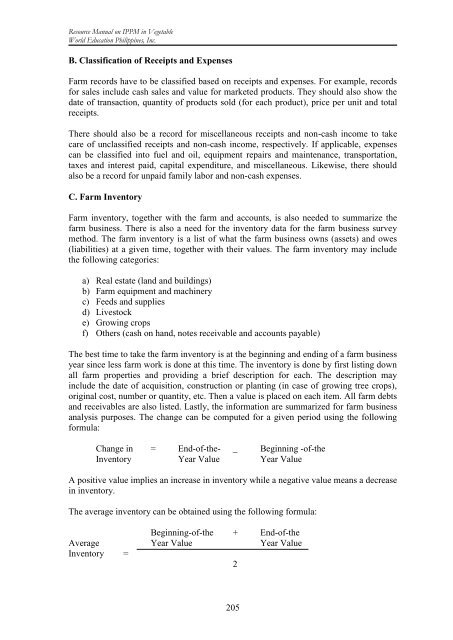Resource Manual on Integrated Production and Pest ... - julitoaligaen
Resource Manual on Integrated Production and Pest ... - julitoaligaen
Resource Manual on Integrated Production and Pest ... - julitoaligaen
You also want an ePaper? Increase the reach of your titles
YUMPU automatically turns print PDFs into web optimized ePapers that Google loves.
<str<strong>on</strong>g>Resource</str<strong>on</strong>g> <str<strong>on</strong>g>Manual</str<strong>on</strong>g> <strong>on</strong> IPPM in Vegetable<br />
World Educati<strong>on</strong> Philippines, Inc.<br />
B. Classificati<strong>on</strong> of Receipts <strong>and</strong> Expenses<br />
Farm records have to be classified based <strong>on</strong> receipts <strong>and</strong> expenses. For example, records<br />
for sales include cash sales <strong>and</strong> value for marketed products. They should also show the<br />
date of transacti<strong>on</strong>, quantity of products sold (for each product), price per unit <strong>and</strong> total<br />
receipts.<br />
There should also be a record for miscellaneous receipts <strong>and</strong> n<strong>on</strong>-cash income to take<br />
care of unclassified receipts <strong>and</strong> n<strong>on</strong>-cash income, respectively. If applicable, expenses<br />
can be classified into fuel <strong>and</strong> oil, equipment repairs <strong>and</strong> maintenance, transportati<strong>on</strong>,<br />
taxes <strong>and</strong> interest paid, capital expenditure, <strong>and</strong> miscellaneous. Likewise, there should<br />
also be a record for unpaid family labor <strong>and</strong> n<strong>on</strong>-cash expenses.<br />
C. Farm Inventory<br />
Farm inventory, together with the farm <strong>and</strong> accounts, is also needed to summarize the<br />
farm business. There is also a need for the inventory data for the farm business survey<br />
method. The farm inventory is a list of what the farm business owns (assets) <strong>and</strong> owes<br />
(liabilities) at a given time, together with their values. The farm inventory may include<br />
the following categories:<br />
a) Real estate (l<strong>and</strong> <strong>and</strong> buildings)<br />
b) Farm equipment <strong>and</strong> machinery<br />
c) Feeds <strong>and</strong> supplies<br />
d) Livestock<br />
e) Growing crops<br />
f) Others (cash <strong>on</strong> h<strong>and</strong>, notes receivable <strong>and</strong> accounts payable)<br />
The best time to take the farm inventory is at the beginning <strong>and</strong> ending of a farm business<br />
year since less farm work is d<strong>on</strong>e at this time. The inventory is d<strong>on</strong>e by first listing down<br />
all farm properties <strong>and</strong> providing a brief descripti<strong>on</strong> for each. The descripti<strong>on</strong> may<br />
include the date of acquisiti<strong>on</strong>, c<strong>on</strong>structi<strong>on</strong> or planting (in case of growing tree crops),<br />
original cost, number or quantity, etc. Then a value is placed <strong>on</strong> each item. All farm debts<br />
<strong>and</strong> receivables are also listed. Lastly, the informati<strong>on</strong> are summarized for farm business<br />
analysis purposes. The change can be computed for a given period using the following<br />
formula:<br />
Change in = End-of-the- _ Beginning -of-the<br />
Inventory Year Value Year Value<br />
A positive value implies an increase in inventory while a negative value means a decrease<br />
in inventory.<br />
The average inventory can be obtained using the following formula:<br />
Beginning-of-the + End-of-the<br />
Average Year Value Year Value<br />
Inventory =<br />
2<br />
205


